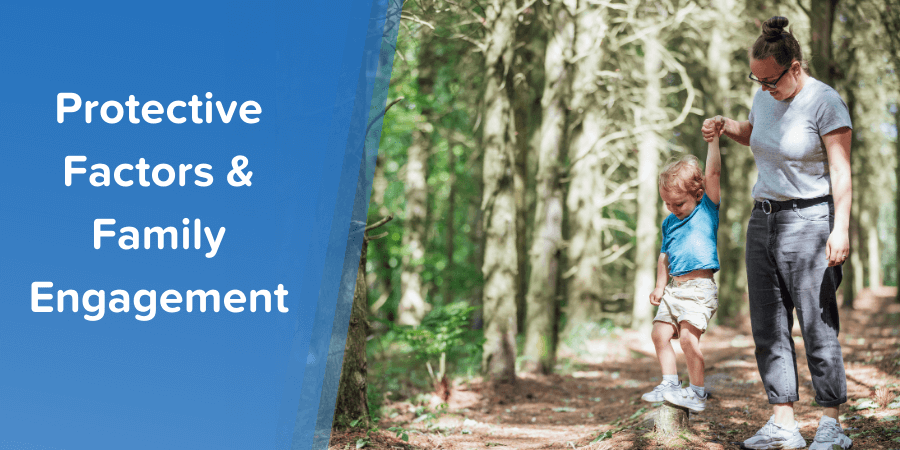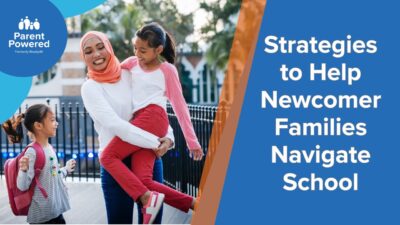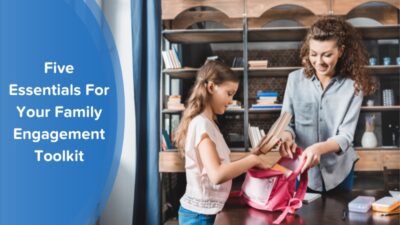By Rebecca Honig, chief content & curriculum officer, and Maren Madalyn, contributing writer
As an educator, it’s one thing to understand terms like “trauma” and “adverse childhood events” when working with students. But when you witness those events, and the lasting impact they have on a child, it changes how you think about trauma forever. And many of us educators can recall an example of how trauma impacted everyday life, either in the students we serve or even in our own lives.
I vividly remember a moment like this with my own family several years ago. My child M. was seven years old at the time, and we were on our way to school. Right as turned onto the school’s street, M. expressed that they were unable to go.
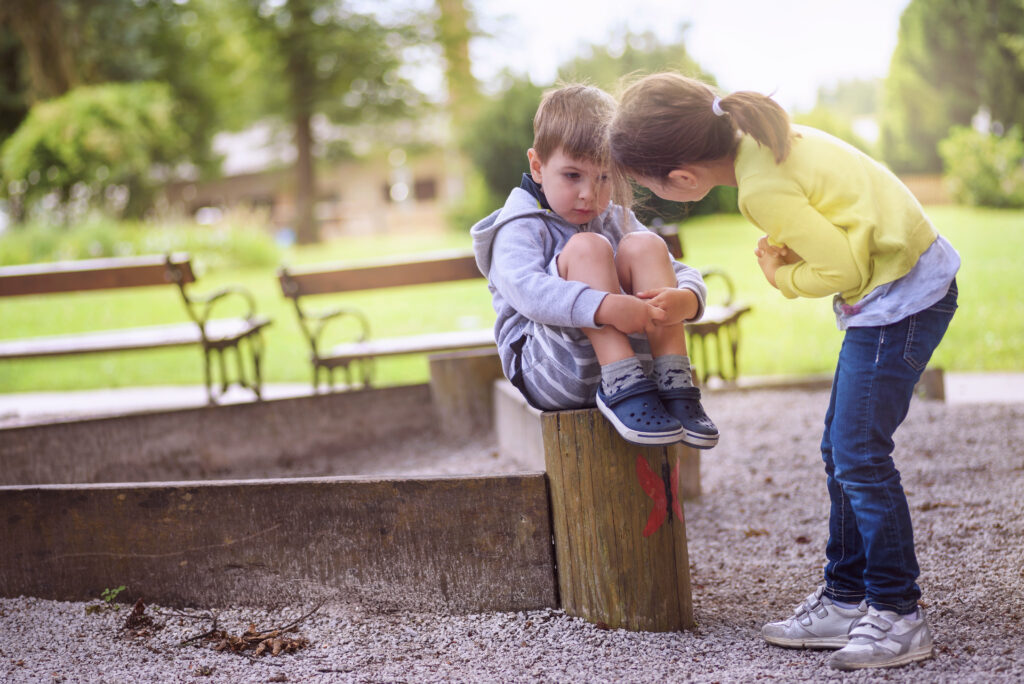
“I can’t go to school,” M. told me. “How can I learn when I know that so much bad stuff can happen?”
M. had lost their grandmother on Mother’s Day the month before this moment. But their list of bad things that could happen extended far beyond the death of a loved one. A single traumatic event had uprooted M.’s whole sense of security, throwing everything into question. It affected M.’s sleep, moods, behaviors and learning.
I ended up keeping M. home that day, and they spent time snuggling, talking, walking the dog, and planting flowers. As evening approached, they shared, “I’m really excited to go to school tomorrow. I remembered about all my protectors.”
“Tell me about them,” I said.
“Well,” M. said with a deep breath, “you and daddy are my protectors, and my sisters are my protectors, and my friends like Mikey and Fionn-with-an-O. And also making up poems and tap dancing and books, too. And my good dream pillow and the backyard…”
Though the trauma of losing their grandmother still affected M., in that moment, they found both solace and a path forward back to learning thanks to these protective factors — conditions or attributes in individuals, families, and communities that promote the health and well-being of children and families.
This story is just one of many that demonstrate the power of protective factors to help kids with building resilience against trauma’s impact. But educators may not always know who is impacted by trauma in their school community. Families, students, and even educators themselves all bring their own experiences to the table, and these experiences can influence how they engage within family-school partnerships, in the classroom, and beyond.
This is why the protective factors framework is so critical for schools and districts. When its guiding principles are woven into the fabric of family, school, and community partnerships, everyone is buffered against the negative effects of trauma, regardless of their past experiences — and everyone has that much greater opportunity to thrive.
Understanding the effects of trauma and how to counter them
Before we dive into the protective factors framework, let’s take a step back and define:
- what trauma is,
- what protective factors are,
- how protective factors differ from risk factors, and
- how all of these concepts apply to trauma-informed approaches to care for families.
Each of these terms is essential for educators, as the protective factors framework is a research-informed approach that can help not only with teaching students but also with family-school partnerships. When educators account for protective factors in their family engagement strategies, they create a pathway for students and families to experience a better future.
What is trauma?
The American Psychological Association defines ‘trauma’ as ‘an emotional response to a terrible event.’ Most educators may be familiar with trauma in the context of adverse childhood experiences (ACEs), which the CDC defines as ‘potentially traumatic events that occur in childhood,’ or anytime between birth through adolescence.
It’s important to remember that what is traumatic for one person may not be for another. Yes, there are certain common examples of trauma that affect many people, such as a natural disaster event or the loss of a loved one as my family and M. experienced. In some cases, however, adverse trauma effects arise after small, repeated exposure to harmful situations, environments, or events.
ACEs and adult experiences with trauma can have devastating consequences on an individual’s health and well-being. Research has shown that there is a significant relationship between the number of ACEs that a person experiences and unhealthy outcomes in adulthood, including addiction rates, substance use, and risky behaviors. ACEs can also negatively impact healthy development in children.
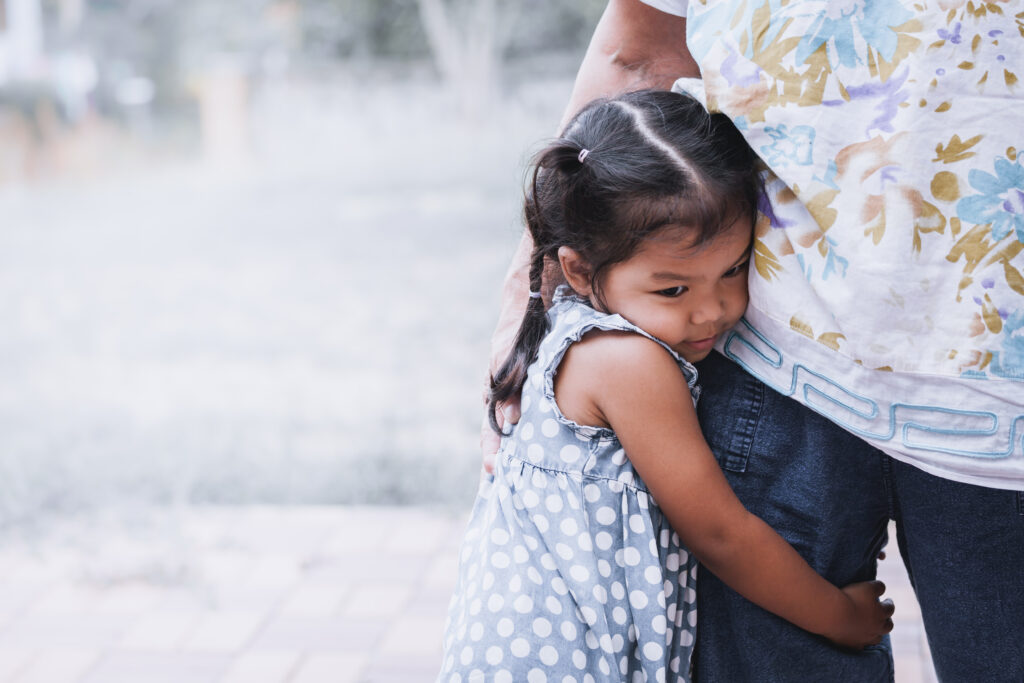
For professionals like child welfare practitioners, social workers, therapists, and educators who work with children who have experienced ACEs, it is critical to leverage what’s called a trauma-informed approach in their work.
What is trauma-informed care?
According to the Buffalo Center for Social Research, applying a trauma-informed lens to care means that a service provider “assumes that an individual is more likely than not to have a history of trauma… [and] recognizes the presence of trauma symptoms and acknowledges the role trauma may play in an individual’s life.” This approach scales up beyond individual practices, too, and is especially powerful at the organizational and programmatic levels.
Another way to think about a trauma-informed approach in action is through the SAMHSA’s 4Rs model. The 4Rs are a guide for practitioners in their everyday practices to:
- Realize the impact that trauma has on wellbeing
- Recognize the signs, symptoms, and effects of trauma
- Respond by integrating knowledge about trauma in practices and policies
- Resist retraumatization of individuals
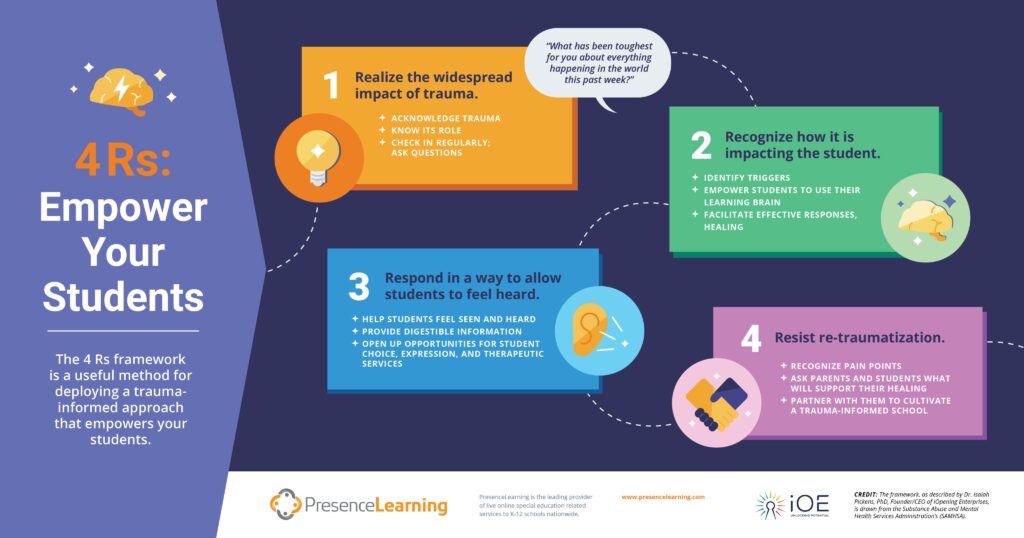
At their core, trauma-informed methods seek to reduce causing unintentional harm and to build trusting relationships while providing services to children and adults.
Risk factors exacerbate trauma — protective factors buffer against it
Research has identified a number of risk factors that may increase the likelihood of child abuse and other ACEs occurring. The Trauma Survivor Network (TSN) highlights the following examples of life stressors that can act as risk factors — many, if not all, of which are not the responsibility of the child experiencing trauma:
- Substance abuse in the family
- Community violence
- Parents’ history of domestic abuse
- Parental stress and distress, including depression and other mental health conditions
In contrast, protective factors can lessen the risk of ACEs, acting as a buffer against the effects of trauma. Protective factors can also promote healthy child development and family strengths.
The Center for the Study of Social Policy (CSSP) synthesized research about protective factors and their impact on countering the effects of trauma into a protective factors framework. Called Strengthening Families, this model is “an organized set of strengths-based ideas that are used to guide programs, services, supports and interventions aimed at preventing child maltreatment and promoting healthy outcomes.”
According to the framework, there are five key protective factors known to reduce harm caused by trauma:
- Parental resilience: Managing stress and functioning well when faced with challenges, adversity and trauma
- Social connections: Positive relationships that provide emotional, informational, instrumental and spiritual support
- Knowledge of parenting and child development: Understanding child development and parenting strategies that support physical, cognitive, language, social and emotional development
- Concrete support in times of need: Access to concrete support and services that address a family’s needs and help minimize stress caused by challenges
- Social and emotional competence of children: Family and child interactions that help children develop the ability to communicate clearly, recognize and regulate their emotions and establish and maintain relationships
These factors are critical for healthcare providers, therapists, and other human service professionals working with children and their families. Protective factors mitigate the negative outcomes from ACEs and set up each child for a brighter future.
Protective factors make all the difference in family engagement
Taking a trauma-informed approach doesn’t just apply to social or mental health workers. In fact, you may have already noticed similarities between the protective factors framework and Dr. Karen Mapp’s Dual Capacity-Building Framework for schools. Dr. Mapp’s model, too, emphasizes using strengths-based strategies to build positive family relationships with teachers, school admin, and other staff supporting kids’ learning. Educators, families, and students all benefit from integrating these protective factors into family-school partnerships.
Research already demonstrates that effective family engagement contributes to a number of positive outcomes for children, including increased academic achievement, increased graduation rates, reduced teacher absenteeism, and overall improved student mental and physical health. Adding the elements of the protective factors framework can further bolster these outcomes.
When educators systemically adopt trauma-informed approaches within their classrooms, schools, and districts, they create opportunities to partner with their families to support student learning. This is especially important for traditionally underserved communities; the protective factors framework offers a path towards greater equity in education.

Of all the protective factors highlighted in the framework, family engagement can make a massive difference in supporting students to cultivate positive social connections. Research shows that when a child has a caring, trusting relationship with even just one adult in their life, they experience higher academic achievement, greater motivation, and improved self-efficacy. Family-school partnerships are all about building a team of caring adults around each student to bolster the child’s wellbeing and academic success.
How then can educators across all grade-levels leverage each of these five protective factors to cultivate family-school partnerships that help students thrive?
Putting the protective factors framework into practice
ParentPowered has worked with hundreds of education partners — including schools, districts, early childhood programs, and community-based organizations — to create everyday learning opportunities for their families that directly benefit student learning. One program in particular is specifically designed to align with the protective factors framework and honor the 4Rs: ParentPowered Trauma Informed.
From our own experiences building this program, we’ve synthesized four examples of how educators can put the protective factors framework into practice to cultivate trust and partnership with their families. Each of these effective strategies can be adapted to fit your unique classroom, school, or community needs.
#1: Reflect on your organization’s current practices
More than half of children in the U.S. have experienced at least one ACE in their lifetime (Felitti et al, 1998), increasing the likelihood that educators will interact with children and families who are navigating the effects of trauma. In order to best serve these families — and, really, all families — educators need to recognize from what point their school is starting on this journey toward trauma-informed practices.
Gather with your team and reflect on your existing family engagement approaches. It’s important to be thoughtful and frank about what may or may not be unintentionally activating for families, as well as what may promote healthy development and learning. Understanding your baseline practices, while identifying opportunities for improvement, helps your team determine their path forward for prioritizing and implementing adjustments. Remember, the goal is to create as much opportunity as possible to cultivate trusting relationships with your families.
Use these guiding questions to begin this process with your team:
- Are there activators in our communications, artifacts shared with families, or behaviors when engaging with families? For example, a hug may be an activating moment for a child who has experienced physical trauma.
- How does our organization scaffold each skill we seek to teach our families and students?
- Are our services and resources accessible to families? (Note: this broad question can apply to everything from physical accessibility to language accessibility!)
- Are we making any assumptions about resources that families have in order to leverage our services or do activities at home for learning?
- Do we use culturally responsive family engagement to honor each family and their lived experiences in our diverse communities? Do we use respectful communication with our diverse families?
- Does our organization recognize and validate each family’s strengths and assets? What opportunities do we have to elevate what our families already have available to support learning?
#2: Invite parents to share their strengths in your communication routines
Though I’ve mentioned this several times already, it bears repeating — a strengths-based approach to engaging with families is extraordinarily powerful.
When educators create communication channels that invite families to share their experiences and knowledge about their children, educators gain critical insights that support their classroom instruction. In turn, families receive strong signals from their school community that their voices matter, that they play a key role in their child’s growth, and that schools want families engaged. These two-way communication routines build trust between home and school, trust that is essential to cultivate a partnership in service of student wellbeing.
Here are concrete examples of such strategies for equitable family engagement as applied to communication routines:
- Elicit family insights from the very beginning! Emails and school forms sent to families at the start of the school year offer an excellent opportunity to bring this idea to life. For example, your teachers can include this blurb in a note to parents: “Just like at home kids experience lots of emotions at school. The more I can recognize how your child is feeling, the better I can address their needs. What are some ways I can tell if your child is feeling excited? What are some ways I can tell if your child is feeling worried or anxious?”
- During parent-teacher conference season, explore flipping the usual script on its head. Instead of having teachers set the agenda, try letting parents lead. Your staff can hold space at the start of each conference to hear families’ concerns, questions, and hopes for their child.
- Repurpose the student take-home folder into a communications tool. Try asking teachers to include a pad of paper and pencil in each student’s folder to collect family questions about school.
- For a more robust shift, begin cultivating a culture of active listening within your school team. Active listening is a powerful communication tool. By practicing active listening among colleagues, educators practice this skill for their communications with families, too. With time and dedication, your active listening practices can also improve school climate.
Read our blog post for more ways to reimagine classic parent engagement strategies.
#3: Create opportunities for families to build positive relationships
Family engagement strategies for schools can cultivate positive social connections not only between students and their adults, but also among the adults themselves. Educators can naturally start with helping families understand the best ways to connect with them and the school. Even returning families benefit from a refresher on the fundamentals of school!
Connect with your families about ways they can reach out and what things to ensure families reach out about. For example, if a parent has a question about school drop-off, do they call their teacher or the school front office? What about when a family has a sick child who needs to miss school, or they simply want to get to know their child’s teacher? Providing explicit guidance to families makes it easier for them and educators to exchange information. You can even consider giving families conversation starters to kick off their connection!
Schools can also encourage families to connect with one another, too. With ParentPowered Trauma-Informed, families receive messages to help them with building and reinforcing healthy relationships in their lives. Trust is the foundation of healthy relationships, and ParentPowered’s programs are designed with this outcome in mind.
Take a look at this example message on the right, sourced directly from our programs. In this prompt, families are encouraged to create a “reach out” routine to build positive social connections and community.
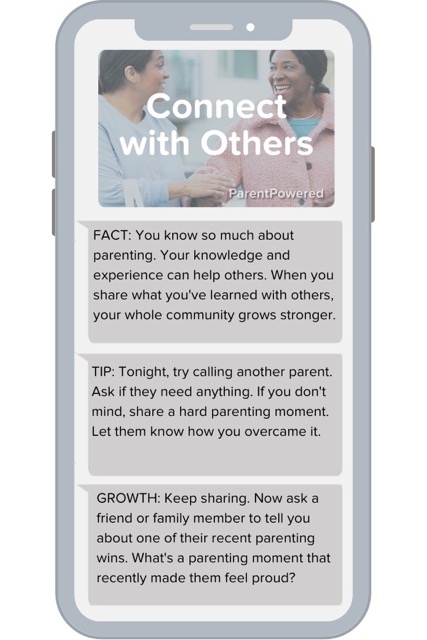
#4: Partner with local organizations to connect families with crucial resources
Schools can become a critical connection point between their families and community services that can help meet families’ most pressing needs.
Using Maslow’s Hierarchy of Needs for guidance, schools can first focus on connecting some families with services that can help them with food, water, and shelter. For other families, it may mean offering resources that promote their physical and psychological safety.

No matter what the need, families that have these essentials in place face fewer barriers to engaging with their school and may also face fewer risk factors for experiencing new or past forms of trauma.
Conduct research among your families about what they need most and which organizations they may already be working with to meet those needs. Then reach out to those organizations first to build a collaborative relationship with them. You can try building a “community resources wall” in your school hallways or front office for parents to grab pamphlets or QR codes that connect them with each organization’s website. Another option is to publish a shout-out about local services in your school newsletter, social media posts, or email blasts.
There are two powerful outcomes with this strategy:
- Educators build trust with their families by partnering with organizations that families may already trust, boosting the protective factor of positive social connections.
- Connecting families with local services also boosts the other four protective factors, too.
For example, a local mental health group can help parents cultivate healthy habits for their own wellbeing and managing stress (to build parental resilience). A community program for new parents can help educate families about their child’s growth and development (building knowledge of effective parenting and the stages of child development).
Connecting families with resources is a core part of ParentPowered Trauma Informed. Here’s an example of such messaging on the right, sent through the Community Support Stream as part of the program. In this case, our partner specifically focused on connecting their families with low-cost and free food services, resources to maintain physical wellbeing, and crisis counseling services.
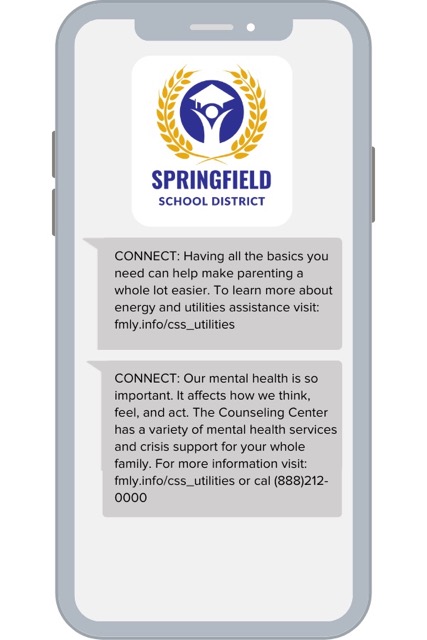
Everyone thrives with protective factors
M.’s protective factors, along with collaboration with our school’s teacher and counselor, were essential to help them build resilience against the trauma of losing their beloved grandmother. And this is just one of many family-school-partnership examples in which the elements of the protective factors framework created positive outcomes for kids and their families.
Looking for ways to bring trauma-informed engagement to your family community? ParentPowered Trauma-Informed is a low-lift, high-impact program designed specifically with these protective factors in mind. Watch a demo to learn more about an evidence- and strengths-based curriculum that grows as kids do, from birth through high school.
About the Authors
Rebecca Honig is the Chief Content and Curriculum Officer at ParentPowered. She has authored numerous curricula, parent guides, and children’s storybooks for Sesame Workshop, Scholastic, Disney, Compass Learning, PBS, WGBH, HITN, Nickelodeon, Mo Willems, and The Norman Rockwell Museum. She has also served as a Curriculum and Content Specialist for Sesame Street and spent ten years teaching in public, private, and after school programs. Rebecca has a Master’s Degree in Early Childhood Education from Bank Street.
Maren Madalyn is a freelance content marketer with over a decade of hands-on experience in education, mental health, and technology. She has served in a variety of capacities, including counseling, customer success, instructional design, and product management.

